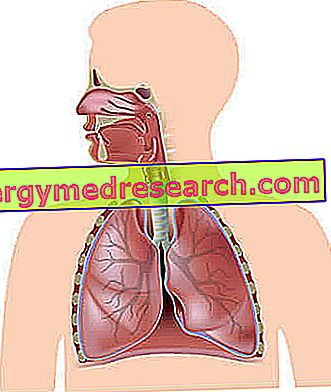Generality
The respiratory system, or respiratory system, is the set of organs and tissues assigned to the important breathing process.
Breathing consists in the assimilation of oxygen inspired by air and in the simultaneous expulsion of carbon dioxide, generated by cellular activity and representing a waste product.

The diseases that affect the respiratory system can be of the type: obstructive, restrictive, vascular or infectious / environmental.
What is the respiratory system?
The respiratory system, or respiratory system, is the set of organs and tissues that provides for the introduction into the body of atmospheric oxygen contained in the air and, simultaneously, to the expulsion of carbon dioxide generated by cellular activity and representing a harmful waste product.
This process is called breathing .
Organization
There are two distinct ways of describing the organization of organs and tissues constituting the respiratory system.
In one way, the respiratory system can be divided into two main components: the respiratory tract exceeds hours (or upper airways ) and the lower respiratory tract (or lower airways ).
To the upper respiratory tract, belong the nose with its nasal cavities, the mouth, the pharynx, the nasopharynx and the larynx; on the lower respiratory tract, on the other hand, the trachea, the bronchi, the bronchioles, the lungs and the diaphragm and intercostal breathing muscles.
According to the second descriptive mode, the respiratory system is a system that has three main portions: the airways, lungs and respiratory muscles .
The airways include: nose, mouth, pharynx, nasopharynx, larynx, trachea, bronchi and bronchioles. The lungs are the functional units on which the introduction of oxygen into the body and the expulsion of carbon dioxide depend.
Finally, the respiratory muscles are the same as mentioned above, namely diaphragm and intercostal muscles.
NASAL AND NASAL CAVITIES
The nose is the main external opening for the airflow of the respiratory system and the very first upper airway tract. It is a structure that includes cartilage, bone, muscle and, obviously, cutaneous tissues.
Thanks to the particular arrangement of some bones of the skull, the nose has, internally, empty spaces that are called nasal cavities .
The nasal cavities play a fundamental role in the physiology of the respiratory system: they, in fact, heat, humidify and filter the inhaled air, before it reaches the lower airways.
In particular, in their filtering action, they use a thin hair and a mucous membrane of coating, capable of blocking dust, mold, allergens and other contaminants that can mix in the air.
MOUTH
The mouth, or oral cavity, represents the secondary external opening of the respiratory system.
In fact, it has the task of helping or, if necessary, replacing the nose in its action of inhaling and expelling air.
The oral cavity is shorter than the nasal cavities and this means that the air entering from the mouth does not undergo the same processes of heating and humidification, typical of when it crosses the internal empty spaces of the nose.
Furthermore, the mouth also lacks hair and a mucous lining similar to the nasal one; therefore it does not perform any filtering action.
However, it has an advantage: the air that enters the oral cavity reaches the lungs much faster, compared to the air that enters the nasal cavities.
PHARYNX
The pharynx is a muscle-membranous conduit about 13 centimeters long, covered by a mucous wall and located between the nasal cavities and the esophagus.
Specifically, it resides:
- Postero-inferior to the nasal cavities (ie behind and lower than the nasal cavities)
- Back to the mouth
- Above the larynx and mouth
Fundamental component of the upper digestive airways ("aerial", because it allows the passage of air, and "digestive", because it allows the passage of food), the pharynx can be divided into 3 compartments: the nasopharynx (or nasopharynx ), the oropharynx and the hypopharynx (or laryngopharynx ).
The nasopharynx is the upper part of the pharynx, placed in direct contact with the choanae, or the two posterior openings of the nasal cavities.
The oropharynx is the intermediate portion of the pharynx. In front of him, he has the oral cavity, with which he communicates through the so-called jaw isthmus.
Finally, the hypopharynx is the terminal section of the pharynx. Deputy solely to inject food into the esophagus, it has no role in the physiology of the respiratory system, since the air does not pass through it.
LARYNX
The larynx is an unequal tube of tubular form, located at the level of the neck, before the beginning of the trachea.
It represents the last stretch of the upper airway and includes, in its structure, several cartilaginous components.
Held together by a series of muscles and ligaments, these cartilaginous components are: the epiglottis, the supraglottis, the glottis and the subglottis.
Externally, the larynx can be placed at the Adam's apple, a typical protrusion of the front of the neck, more evident in men than in women.
Seat of the vocal cords, the larynx covers three fundamental roles:
- It channels the air towards the trachea, then towards the lungs.
- It allows speech, thanks to the vibration of the vocal cords.
- Thanks to the epiglottis, it prevents food from entering the trachea and obstructing the airways when swallowing.
TRACHEA
Located between the larynx and the bronchi, the trachea is the elastic and flexible conduit, to which the anatomists entrust the canonical role of the first tract of the lower airways.
The trachea is usually 12 centimeters long and has a diameter of about 2 centimeters.
Above, it originates from a cartilaginous portion of the larynx (about the height of the sixth cervical vertebra); inferiorly, it ends at the bifurcation from which the primary bronchi arise.
From the point of view of structural organization, the trachea consists of 15-20 superimposed cartilaginous rings, similar to horseshoes and held together by connective tissue. Later on, these rings have smooth muscle fibers which, as a whole, form the so-called tracheal muscle.
As regards the neighboring elements, behind the trachea the esophagus takes place, while, on its sides, resides the vascular-nervous bundles of the neck.
BRONCHI AND BRONCHIOLI
The bronchi and bronchioles constitute that tract of the lower airways that the anatomists call the bronchial tree .
The bronchial tree is a rather complex structure, which includes the airways outside the lungs and the airways inside the lungs (or intrapulmonary):
- The airways outside the lungs of the bronchial tree are the so-called extrapulmonary primary bronchi of the right and left. The right extrapulmonary primary bronchus heads towards the right lung, while the left extrapulmonary primary bronchus goes towards the left lung.
- The intrapulmonary airways of the bronchial tree are the secondary bronchi, the tertiary bronchi, the bronchioles, the terminal bronchioles and the respiratory bronchioles .


Located at the ends of the terminal bronchioles, that is the final branches of the bronchi, the alveoli have an extensive, very elastic parietal surface, which serves to increase the area for gas exchange.
From the histological point of view, the bronchi-bronchiole complex progressively changes its structure as it enters more and more into the lungs. In fact, if in the primary bronchi the cartilaginous component is predominant on the muscular component (NB: there is considerable similarity with the trachea), starting from the secondary bronchi the muscular component takes over and gradually replaces the cartilaginous component.
The inner wall of bronchi and bronchioles has an important epithelium of cilia (or ciliary epithelium) and cells that produce mucus (or mucous cells): the cilia and mucus are used to trap contaminants (dust, mold, allergens, etc.), present in the inhaled air, and to remove them from the airways.
As far as the functional aspect is concerned, the bronchi and bronchioles serve to transport air from the trachea to the lungs.
LUNGS
The lungs are the two main organs of the respiratory system. Composed of spongy and elastic tissue, they reside in the thoracic cavity, one on the right and one on the left, on the sides of the heart and above the diaphragm.
The right lung is larger than the left lung, weighs about 600 grams (in an adult) and has deep fissures, which divide it into three portions called lobes (upper lobe, middle lobe and lower lobe).
The left lung, on the other hand, generally weighs 500 grams and has a series of deep fissures, which divide it into just two lobes (the upper lobe and the lower lobe).
The smaller size of the left lung, compared to the right lung, has a precise anatomical meaning: it serves, in fact, to guarantee an adequate space for the heart.
The spongy and elastic tissue that makes up the lungs allows them to expand, during the air introduction phase ( inspiration ), and return to normal, during the expulsion phase of carbon dioxide ( expiration ).
Wrapped externally by the so-called pleural membrane, the lungs have inside them small cavities or pockets, capable of containing air, which are called alveoli or pulmonary alveoli .
The alveoli have elastic walls and represent the place where the organism acquires the oxygen of the inhaled air and expels the carbon dioxide produced by the cellular activity. Therefore, they are fundamental within the physiological framework of the respiratory system.
A set of alveoli forms the so-called pulmonary berry ; a pulmonary berry (or more simply a berry) resides at the end of a terminal bronchiole.
A group of several pulmonary acini, with their respective terminal bronchioles, constitutes the smallest pulmonary structure visible to the naked eye: the pulmonary lobule (or lobule). A generic pulmonary lobule has more internal berries, called central berries, and peripheral berries, called distal.
RESPIRATORY MUSCLES
The diaphragm is the main respiratory muscle. Belonging to the category of skeletal muscles, it resides on the lower edge of the thoracic cage, marking the border point between the thorax and the abdominal cavity. It is an unequal, cupoliform and laminar muscle.
From the functional point of view, the diaphragm contracts during the air introduction phase, while it relaxes during the carbon dioxide expulsion phase.
When it contracts, it lowers the abdominal organs, allowing the rib cage to expand and the lungs to have more space to expand.
When instead it relaxes, it allows the abdominal organs to ascend, reducing the size of the thoracic cage and depriving the lungs of the space created during the contraction phase.
Moving on to the other category of respiratory muscles, namely the intercostal muscles, these are muscular elements located in the so-called intercostal space . The intercostal space is the space existing between two overlapping ribs.
There are two categories of intercostal muscles:
- The external intercostal muscles, which raise the ribs and favor the expansion of the rib cage (inspiration).
- The internal intercostal muscles, which lower the ribs and reduce the volume of the rib cage (expiration).
Functions
As we said at the beginning, the respiratory system has the task of providing for breathing.
Breathing can be divided into two phases: the inspiration phase and the exhalation phase.
During the inspiration phase, the air enters through the nose, passes through its cavities, passes through the pharynx and the larynx, reaches the trachea and, from here, through the bronchial tree, reaches the pulmonary alveoli.
The pulmonary alveoli are the site of the development of the so - called blood-alveoli (or hematosis ) gas exchanges, exchanges during which the blood draws oxygen from the inhaled air and, at the same time, discharges the carbon dioxide.
The expiration phase begins after the gaseous blood / alveolus exchanges and sees the air now poor in oxygen, but rich in carbon dioxide, retracing the path that took it to the lungs in the opposite direction and exit.
GASSOUS EXCHANGES: SOME DETAILS
Blood-alveoli gas exchange is possible because the pulmonary alveoli have a very thin wall, which allows the passage of gases such as oxygen and carbon dioxide, and because there is a dense network of capillaries all around the pulmonary alveoli blood vessels .
These blood capillaries are the fruit of the intertwining on one side of branches of the pulmonary artery, which carries oxygen-poor blood and is rich in carbon dioxide, and on the other side of branches of the pulmonary vein, in which blood rich in blood flows. oxygen and low in carbon dioxide.
Once the inhaled air has reached the alveoli, the blood present in the pulmonary artery capillaries releases its own carbon dioxide, in exchange for the oxygen in the air present in the alveolar cavities.
After the exchange, the blood flows into the capillaries which then lead it to the pulmonary veins.
The pulmonary veins are directed to the heart and introduce in the latter the blood that will have to reach and oxygenate the organs and tissues of the whole organism.
Illnesses
Pathologist doctors classify the conditions that can affect the respiratory system in:
- Obstructive conditions or obstructive diseases
- Restrictive conditions or restrictive diseases
- Vascular conditions or vascular diseases
- Infectious / environmental conditions or infectious / environmental diseases
OBSTRUCTIONS OF THE RESPIRATORY SYSTEM
The main feature of the obstructive diseases of the respiratory system is the narrowing - which in the most serious cases becomes occlusion - of the airways.
The list of obstructive diseases of the respiratory system includes conditions such as: pulmonary emphysema, chronic obstructive pulmonary disease (COPD), bronchitis and asthma.
Readers interested in learning more about these topics can click:
- Here, for the symptoms and, here, for the medications in case of pulmonary emphysema
- Here, for symptoms and, here, for COPD medications
- Here, for the treatment and treatment of COPD soon
- Here, for the symptoms and, here, for the drugs in case of bronchitis
- Here, for the symptoms and, here, for the asthma medications
- Here, to know what bronchospasm is, typical of bronchitis and asthma
RESTRICTIVE DISEASES OF THE RESPIRATORY SYSTEM
The typical characteristic of restrictive respiratory diseases is the diminished capacity of expansion by the particular spongy and elastic tissue of the lungs.
This diminished capacity leads to a reduced possibility of lung expansion, therefore a lesser introduction of air during inspiration.
The main restrictive conditions of the respiratory system are: pulmonary fibrosis, pulmonary interstitial disease, sarcoidosis and pleural effusion.
To learn more about these issues, readers can click:
- Here, for the brief symptoms of pulmonary fibrosis
- Here, for the symptoms and, here, for the drugs in the case of sarcoidosis
- Here, for the symptoms and therapy of pleural effusion
VASCULAR DISEASES OF THE RESPIRATORY SYSTEM
The typical characteristic of vascular diseases of the respiratory system consists in the presence of a problem at the level of the pulmonary blood vessels, whether these are the alveolar capillaries, the branches of the pulmonary arteries, etc.
Among the classic vascular diseases of the respiratory system are pulmonary edema, pulmonary embolism and pulmonary hypertension.
For a deeper understanding of the aforementioned morbid conditions, readers can click:
- Here, for the brief symptoms of pulmonary edema
- Here, for the symptoms and, here, for the drugs in case of pulmonary embolism
- Here, for the symptoms and, here, for the medications in case of pulmonary hypertension
INFECTIOUS / ENVIRONMENTAL DISEASES OF THE RESPIRATORY SYSTEM
The characterizing element of the infectious diseases of the respiratory system is the viral, bacterial or fungal origin of the condition.
The element that instead distinguishes the environmental diseases of the respiratory system is exposure to a particular environmental factor. An environmental factor is any circumstance, event or habit that can affect an individual's life to a certain extent.
Some of the most famous infectious diseases of the respiratory system are: pneumonia, tuberculosis and tracheitis. For further information on the subject, readers can click:
- Here, for the symptoms and, here, for the medications in case of pneumonia
- Here, for the symptoms and, here, for the drugs in case of tuberculosis
- Here, for the brief symptoms of tracheitis
Among the environmental diseases of the respiratory system, asbestosis and silicosis pneumoconiosis deserve a mention.



